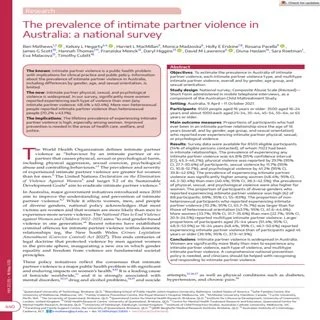By Ben Mathews, Kelsey L Hegarty, Harriet L MacMillan, Monica Madzoska, Holly E Erskine, Rosana Pacella, James G Scott, Hannah Thomas, Franziska Meinck, Daryl Higginss
Objectives: To estimate the prevalence in Australia of intimate partner violence, each intimate partner violence type, and multitype intimate partner violence, overall and by gender, age group, and sexual orientation.
Study design: National survey; Composite Abuse Scale (Revised)—Short Form administered in mobile telephone interviews, as a component of the Australian Child Maltreatment Study.
Setting: Australia, 9 April – 11 October 2021. Participants 8503 people aged 16 years or older: 3500 aged 16–24 years and about 1000 each aged 25–34, 35–44, 45–54, 55–64, or 65 years or older.
Main outcome measures: Proportions of participants who had ever been in an intimate partner relationship since the age of 16 years (overall, and by gender, age group, and sexual orientation) who reported ever experiencing intimate partner physical, sexual, or psychological violence.
Results: Survey data were available for 8503 eligible participants (14% of eligible persons contacted), of whom 7022 had been in intimate relationships. The prevalence of experiencing any intimate partner violence was 44.8% (95% confidence interval [CI], 43.3–46.2%); physical violence was reported by 29.1% (95% CI, 27.7–30.4%) of participants, sexual violence by 11.7% (95% CI, 10.8–12.7%), and psychological violence by 41.2% (95% CI, 39.8–42.6%). The prevalence of experiencing intimate partner violence was significantly higher among women (48.4%; 95% CI, 46.3–50.4%) than men (40.4%; 95% CI, 38.3–42.5%); the prevalence of physical, sexual, and psychological violence were also higher for women. The proportion of participants of diverse genders who reported experiencing intimate partner violence was high (62 of 88 participants; 69%; 95% CI, 55–83%). The proportion of non-heterosexual participants who reported experiencing intimate partner violence (70.2%; 95% CI, 65.7–74.7%) was larger than for those of heterosexual orientation (43.1%; 95% CI, 41.6–44.6%). More women (33.7%; 95% CI, 31.7–35.6%) than men (22.7%; 95% CI, 20.9–24.5%) reported multitype intimate partner violence. Larger proportions of participants aged 25–44 years (51.4%; 95% CI, 48.9–53.9%) or 16–24 years (48.4%, 95% CI, 46.1–50.6%) reported experiencing intimate partner violence than of participants aged 45 years or older (39.9%; 95% CI, 37.9–41.9%).
Conclusions: Intimate partner violence is widespread in Australia. Women are significantly more likely than men to experience any intimate partner violence, each type of violence, and multitype intimate partner violence. A comprehensive national prevention policy is needed, and clinicians should be helped with recognising and responding to intimate partner violence.
Medical Journal of AustraliaVolume 222, Issue 9, May 2025, Pages, 423-480





















